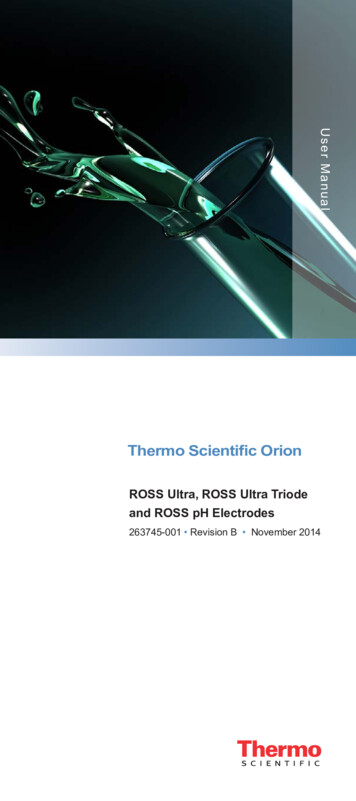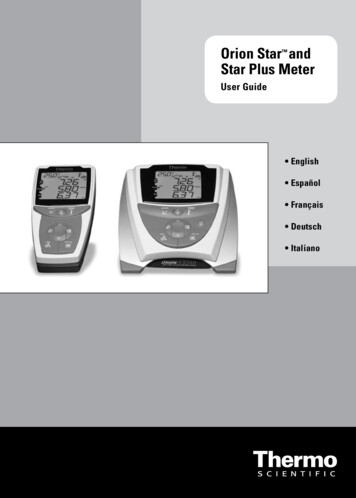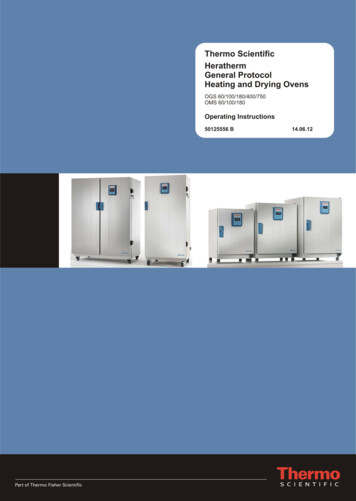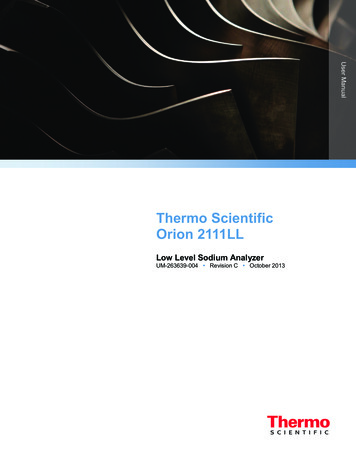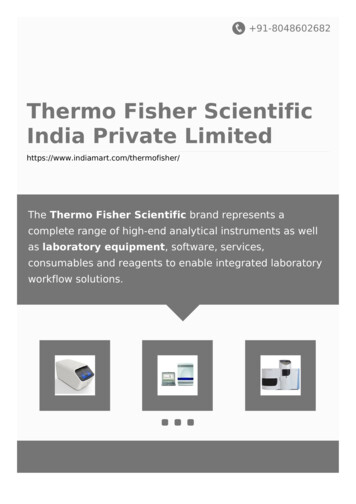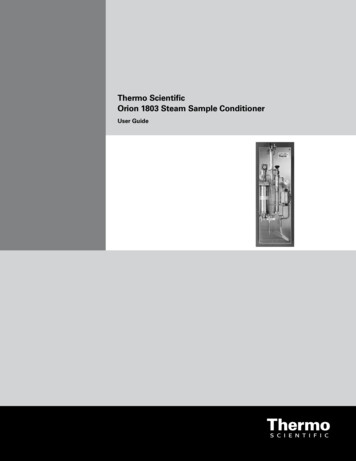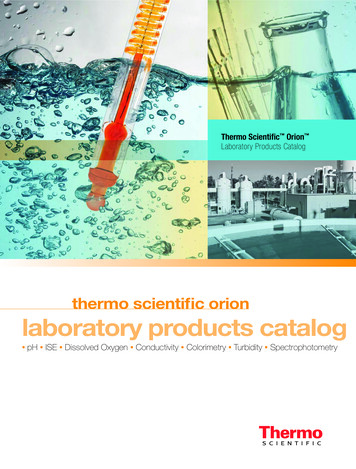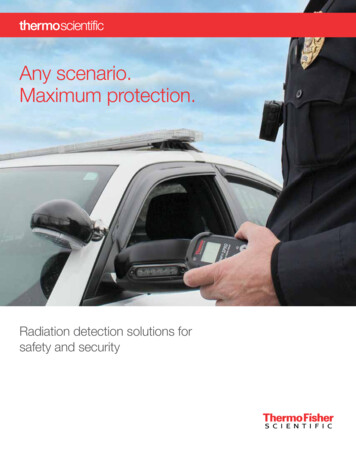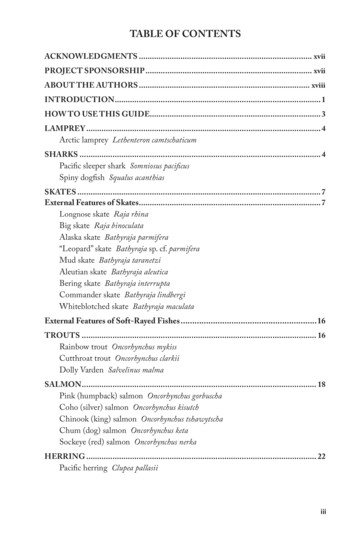
Transcription
Thermo Scientific Orion Star T900Series Potentiometric TitratorsUser Manual68X700190 Revision 2.0 December 2019
ContentsChapter 1 . 6Titrator Overview . 6Introduction. 6Titrator Overview. 6Terminology . 7Safety Precautions . 9Chapter 2 . 11Unpacking and Initial Setup . 11Unpacking the Titrator . 11Titrator Initial Setup. 12Attaching the Electrode Holder . 12Installing the Burette . 13Installing the Tubing . 14Installing Electrodes, Accessories and Devices . 14Connecting the Electrodes and Probes . 14Connecting the Power Supply. 14Connecting External Devices . 15Updating Titrator Software . 15Chapter 3 . 16Titrator Preparation . 16Instrument Setup Wizard . 16Titrator Home Screen . 16Titrant Preparation . 18Changing the Titrant . 18Titration Setup Wizard . 19Step 1: Setup Electrode . 19Step 2: Setup Titrant. 20Step 3: Setup Titration . 22Example Parameter Settings from App Notes . 25General Settings. 32
Diagnostics . 32Display. 32Temperature Input . 32Files and Info . 32Notifications . 32Logs . 33Exporting Data Logs . 33Orion Star T900 Series Computer Software . 34Methods . 37Using Preprogrammed Methods . 38Burette . 38Direct Measure . 39Chapter 4 . 41Titrator Use and Maintenance . 41Titration Mode . 41Standardization Mode . 44Calibrate Mode. 46MKA Mode. 48Maintenance Schedule . 50General pH Electrode Maintenance . 51Dispense Verification Procedure . 51Titrator and Burette Storage . 53Chapter 5 . 54Customer Services. 54Troubleshooting . 54Troubleshooting Checklist . 54Frequently Asked Questions . 54Warranty Information. 57Technical Support Assistance . 58Regulatory Statements . 59Titrator Specifications . 60Ordering Information. 62Chapter 6 . 66
Appendix . 66Calculating a Reaction Ratio . 66Selecting the Result Units . 66Titration Result Units . 66MKA Result Units. 67Titrator Calculations. 67Direct Titration Calculations. 67Blank Correction in Direct Titration . 67Back Titration Calculations . 68Reaction Ratios in Back Titration. 68Amount of Reagent in Back Titration . 68Concentration Calculation in Back Titration . 69Multiple Endpoints . 70Titrant Standardization . 70Multiple Known Addition (MKA) . 71User Defined Results . 72
Chapter 1Titrator OverviewIntroductionTitrator OverviewThermo Scientific Orion Star T900 series laboratorytitrators are designed to increase lab productivity byautomating potentiometric titrations. These compact titratorsare simple to use with easy navigation from setup to livetitration analysis to data transfer, all on a large color graphictouchscreen display. Create and save up to ten customuser-defined methods or use preprogrammed protocols, allwith onscreen instructions and help menus, so everyone inthe lab can be up to speed quickly and easily.We have integrated our core electrochemistry technologywith a state-of-the-art reagent dispensing system to create amodern, simplified automated titrator designed to makeperforming titrations easier, more reliable, more reproducibleand faster than manual titrations. Our automated titratorsexpand the number of ions and compounds that can bemeasured beyond direct electrode analysis and offerdynamic process controls that adjust the titration to optimizeanalysis results.The Orion Star T900 series titrators include four models: Orion Star T910 pH titrator Orion Star T920 redox titrator Orion Star T930 ion titrator Orion Star T940 all-in-one titratorThese titrators have the ability to calibrate the electrode(sensor), standardize titrants and perform various types ofpotentiometric titrations. The Orion Star T930 ion titrator andOrion Star T940 all-in-one titrator offer the added benefit ofmultiple know addition (MKA) analysis, where the titratorperforms an automated calibration and calculation of sampleconcentration by adding aliquots of standard to sample.Ideally suited for dedicated, routine measurements, the OrionStar T900 series titrators are designed to help laboratoriesovercome problems of sample throughput or analytical6Chapter 1 Titrator Overviewcomplexity through automation of analysis. Whatdifferentiates the Orion Star T900 series titrators from othersingle parameter instruments and automatic titrators are theirsimplicity. All setup procedures appear on the display in theform of easy-to-understand, sequential menus. Because theanalysis is automated, each titration step is carried outconsistently time after time, operator to operator, using ahigh precision burette that meets ISO 8655 standard.Whether the analysis is acidity of juices, alkalinity of water,surfactants in shampoo, fluoride in drinking water or VitaminC in juices, the Orion Star T900 series titrators offer a simplesystem to automate measurements. Please visitwww.thermofisher.com/titrator for additional information onThermo Scientific Orion instruments, electrodes andsolutions.Use the Orion Star T910 pH titrator for dedicated acid-basetitrations including titratable acidity of juices and wines,acidity of food products, alkalinity of waters, acidity andalkalinity of consumer products, total acid number (TAN) andtotal base number (TBN). Titration techniques includeequivalence point titrations and preset pH endpoint titrations.Use the Orion Star T920 redox titrator for dedicated redoxtitrations including sulfite/SO2 and reducing sugar in juice andwine, ascorbic acid (vitamin C) and peroxide value in foodproducts, dissolved oxygen in wastewater by Winkler titrationand organic matter in soil. Titration techniques includeequivalence point titrations and preset mV endpointtitrations.Use the Orion Star T930 ion titrator for dedicated ionconcentration titrations including salt in food products,chloride in drinking water and wastewater, ammonia andTotal Kjeldahl Nitrogen (TKN) of wastewater, surfactants inconsumer products and total hardness of drinking water andwastewater. Titration techniques include equivalence pointtitrations and preset mV endpoint titrations plus multipleknown addition (MKA) mode. Using MKA mode, the titratorperforms an automated calibration and calculation of sampleconcentration by adding aliquots of standard to sample,removing the need for a separate calibration and minimizingmatrix effects.Use the Orion Star T940 all-in-one titrator for flexible pH,redox and ion concentration titrations including equivalencepoint titrations, preset pH or mV endpoint titrations plusmultiple known addition (MKA) mode for automated knownaddition of various ions.
TerminologyThe terminologies used in this manual are explained here:TitratorThe device used to perform the titration, titrantstandardization or direct measurement.TitrantReagent of known concentration that is added to a sampleand results in an observable reaction and endpoint orequivalence point.SampleSolution of unknown concentration that is titrated using atitrant to determine the concentration.BuretteComponent that dispenses a measured volume of titrant intothe sample by pulling the titrant from the reagent bottle intothe burette and then pushing the titrant from the burette tothe dispensing probe and into the sample.ElectrodeAlso called probe or sensor, the device in the solutionperforming the measurement.ModeMeasurement type being used by the titrator (pH, mV, ISE).MethodA set of saved parameters and values for a particular titrationincluding the electrode, titrant and titration setup parametersas well as electrode calibration and titrant standardizationwhen applicable.pHpH measurements compare the relative acidity or alkalinity ofa solution at a given temperature. A pH of 7 describes aneutral solution because the activities of hydrogen andhydroxide ions are equal. When the pH is below 7, thesolution is described as acidic because the activity ofhydrogen ion is greater than that of hydroxide ion. A solutionis more acidic as the hydrogen ion activity increases and thepH value decreases. Conversely, when the pH is above 7,the solution is described as basic (or alkaline) because theactivity of hydroxide ion is greater than that of hydrogen ion.Redox / ORPORP (Oxidation / Reduction Potential) measures the oxidizingor reducing nature of a sample. This gives an overallindication of how "reactive" the sample is. ORPmeasurements are common in water, wastewater, processwater and plating bath applications.ISE (Ion Selective Electrode)Ion selective electrodes measure the concentration ofspecific ions in sample solutions such as water, wastewater,consumer goods, foods and beverages. Ion selectiveelectrodes are available for ammonia, ammonium, bromide,cadmium, calcium, carbon dioxide, chloride, chlorine, cupric,cyanide, fluoride, fluoroborate, iodide, lead, nitrate,potassium, silver, sodium, sulfide, surfactant andthiocyanate.All-in-OneTitrator that combines the functionality of the pH, redox andion titrators into one unit.TitrationTechnique that is based upon the addition of a reagent(titrant) that reacts with the sample species. The changes inelectrode potential are observed and sample concentration iscalculated from the volume of reagent that is chemicallyequivalent to the sample species.Equivalence/Inflection Point TitrationTechnique of adding small aliquots of a titrant to the sample,recording the potential changes and applying a first derivativeanalysis to the data, from which the equivalence point(inflection point of the curve) is calculated. The techniqueassumes that the change in mV reading per volume of titrantadded will be greatest at the equivalence point. Thistechnique is a very precise technique for performing routinetitrations with a sharp, clear inflection point.Preset Endpoint TitrationType of titration where aliquots of the titrant are added until apredetermined mV or pH value is reached. This is a fast wayto do a titration, but requires that the sample and its reactionwith the titrant be well known. The preset endpoint techniqueis useful for analyses without a clearly defined inflection pointand is often a technique required by industry standards.Multiple Known Addition (MKA)Known addition is a technique of adding small aliquots of thespecies of interest to the sample and calculating the originalsample concentration from the observed changes inpotential. The electrode chosen for analysis should sense theOrion Star T900 Series Titrator7
species of interest. This technique helps minimize matrixeffects and offers greater precision than direct calibrationmeasurement.In multiple known addition, three or more additions are madeto the sample allowing electrode slope, Eo, sampleconcentration and a spike recovery to be calculated. This is avery precise technique because the calibration is performeddirectly in the sample matrix during analysis.Unique benefits of multiple known addition include the levelof precision of the analysis may be chosen and each sampleanalysis is automatically verified by a spike recovery analysis.Direct TitrationTechnique in which the titrant reacts directly with thechemicals in the sample solution and titrant consumption isdirectly related to the quantity of the chemicals in the sample.Back TitrationTechnique in which excess quantity of a reagent is added tothe sample, so that the entire sample reacts with the reagentand some un-reacted reagent remains. The un-reactedexcess reagent is titrated with suitable titrant. If the amountof reagent added to the sample is known, the sampleconcentration can be calculated.Blank and Blank TitrationA blank is used when performing a back titration or when abackground correction is necessary (background level of themeasured species is present prior to analysis). The blankvalue can be manually entered or automatically calculated byperforming a blank titration. Whether a blank value ismanually entered or determined by blank titration, make surethat all samples analyzed by that method are prepared in thesame manner. If the sample preparation changes, a newblank must be manually entered or determined by blanktitration. Most routine titration methods do not require ablank.ROSS pH ElectrodesNot all pH electrodes are created equal – It is critical that themeasurements customers perform day-to-day are accurateand reproducible. Customers rely on their pH electrodes tomeasure their samples quickly and precisely, making pHelectrodes an essential part of the lab. ROSS pH electrodesoffer superior measurement stability, fast response, highaccuracy and precision even in samples with varyingtemperatures, no long-term drift and long lifespan.Orion Ion Selective Electrodes (ISEs)8Chapter 1 Titrator OverviewMeasurement by an ion selective electrode (ISE) can beperformed in virtually every laboratory. Efficient andeconomical - electrode measurements can be simpler andfaster than other analytical techniques. Time consumingsample steps such as filtration and distillations are rarelyneeded and analysis time is typically 1-2 minutes per sample.Compared to other analysis methods, there is a relativelysmall setup cost. Ion selective electrodes can be used fordetermination of a titration endpoint and are useful asendpoint detectors because they are unaffected by samplecolor or turbidity.Orion Electrochemistry SolutionsCustomers need to be able to rely on their measurementsand using high-quality solutions to calibrate and maintainelectrodes is the best way to ensure data is both accurateand reproducible. Using low-quality, home-made, or expiredbuffers can lead to measurement errors, which requirelengthy troubleshooting, or even worse – can go unnoticed.Using high-quality solutions eliminates one of the majorcauses of measurement inaccuracy.Orion solutions are manufactured for accuracy andrepeatability to the highest quality standard in the industry.Orion solutions are produced in controlled batches usingultra pure water and undergo rigorous quality testingthroughout the process to prevent contamination before andafter bottling. Buffers and standards have lot-specificcertificates of analysis with NIST-traceable testing results.
Safety PrecautionsThermo Fisher Scientific does not accept any liability fordamage that may arise if information in this manual is notfollowed. Therefore, the operating instructions andspecifications must be read and understood by all personsinvolved in installation and operation of this equipment.Thermo Fisher Scientific will not be liable for direct, indirect,special, incidental or consequential damages resulting fromany defect or omission in this manual. Thermo FisherScientific reserves the right to make changes in this manualand the products it describes at any time, without notice orobligation. Revised editions are found on the Thermo FisherScientific website. Intended operators should read andunderstand the entire manual before operating this system.Special attention should be given to all safety and cautionnotes contained in this manual and the Low Voltage Directive(LVD) document. Failure to do so could result in serious injuryto the operator or damage to the equipment.Definition of Signal Warnings and SymbolsSafety notes are marked with signal words and warningsymbols. These show safety issues and warnings. Ignoringthe safety notes may lead to personal injury, damage to theinstrument, malfunctions and false results. Make sure thatthe protection provided by this equipment is not impaired.Do not use or install this equipment in any manner other thanthat specified in this manual.CAUTION: Indicates a hazardoussituation with low risk resulting in damageto the device or the property or in loss ofdata or minor or medium injuries if notavoided.WARNING: Indicates a hazardoussituation with medium risk possiblyresulting in severe injuries or death if notavoided.ATTENTIION:Indicates important function of the product.Note: Indicates useful information about the product.WARNING: Indicates situations wheredangerous voltages exist and potentialfor electrical shock is present.This symbol indicates that a risk ofexplosion is present.Orion Star T900 Series titrators utilize instrument technologythat complies with all industry recognized safety rules.Certain hazards may arise in extraneous circumstances.NEVER open the housing of the instrument. It is not meant tobe maintained or repaired by the user. Opening theinstrument may jeopardize the safety and accuracy of theinstrument. If you ever have problems with the instrument,contact your authorized Thermo Fisher dealer or servicerepresentative.Intended UseThis instrument is designed to perform potentiometrictitrations in laboratory environment by knowledgeablelaboratory technicians trained to operate titrations. It issuitable for the processing of reagents and solvents. The userequires knowledge and experience in working with toxic andcorrosive substances which pose inherent danger. Use ofthis instrument requires knowledge and experience workingwith application specific reagents, which may be toxic orhazardous.Location SafetyThe instrument must be operated indoors only and must notbe used in explosive environment. Place the instrument in awell-ventilated location where it can rest in leveled position,protected from direct sunlight or sources of excessive heat,corrosive atmosphere and mechanical upset (danger ofbeing knocked down, exposed to strong vibrations etc.).Operate at temperatures between 5 C and 40 C. Avoidenvironment with frequent temperature changes as theyinfluence bubble formation and potentially affect theaccuracy.CAUTION: Always wear protective clothing inthe laboratory when working with theinstrument. A lab coat and eye protection suchas goggles should be worn. Use appropriate(and undamaged) gloves when handlingchemicals or hazardous substances.Orion Star T900 Series Titrator9
WARNING: Risk of electric shock:Power to the instrument is supplied witha 3-pin grounded power cable. Alwaysmaintain the grounding of the instrumentfor safety reasons. Never useungrounded electrical outlet or extensioncables without grounding conductors.NEVER defeat the grounding intentionally.WARNING: Risk of corrosion: Tubing,connections and loose titration vesselsare a safety risk. They all can leakcorrosive liquids. To prevent this:1.Make sure all connectionsare tightened well by hand,avoiding excessive force toprevent damage.2.When making tubingconnections, be careful toavoid cross threading of thefitting.3.Inspect all tubing for signs ofrupture or other damage.4.Inspect all vessels for signsof damage or leaks.5.Before using corrosive ortoxic reagents, run the testwith water to make sure allleak free and safe.WARNING: Flammable solvents:All relevant safety measures must beobserved when working with flammablesolvents and chemicals. Always consultSDS (Safety Data Sheet) for the liquidsthat will be used.1.Your workplace must not bein proximity of any sources offlame or excessive heat.2.Always consult and complywith SDS (Safety Data Sheet)and recommendations fromthe manufacturer for anysolvents and chemicals.3.Always observe general labsafety rules.WARNING: Chemicals: All relevant safetymeasures are to be observed whenworking with chemicals.1.Set up the instrument in awell-ventilated location.2.Any spills should be wipedoff immediately.3.Always consult and comply10Chapter 1 Titrator Overviewwith SDS andrecommendations from themanufacturer for anysolvents and chemicals.WEEE Compliance: This product is requiredto comply with the European Union’s WasteElectrical & Electronic Equipment (WEEE)Directive 2012/19/EU. It is marked with thesymbol shown here. Thermo Fisher Scientifichas contracted with one or more recycling /disposal companies in each EU Member Stateand this product should be disposed of orrecycled through them. Further information oncompliance with these directives, the recyclersin your country, and information on ThermoScientific Orion products that may assist thedetection of substances subject to the RoHSDirective are available by contacting us usingthe contact information in this user manual
Chapter 2Unpacking andInitial SetupThe Orion Star T900 series titrator packaging contains thefollowing items: Titrator 20 mL Burette Burette Cover Electrode Holder Stirrer ProbeUnpacking the Titrator Dispenser Probe Standard Tubing KitUnpack the Orion Star T900 series titrator from its shippingcarton and inspect it for damage. Verify that all the partslisted here are included. If damage is evident or if theshipment is incomplete, please contact your local distributoror Technical Service at wlp.techsupport@thermofisher.com.It is recommended that you keep the titrator box, and do notdispose of it during unpacking, so it can be used forrepacking and long-term storage. Drying Tube for Desiccant Reagent Bottle Holder 1 L Plastic Reagent Bottle GL38 Reagent Bottle Cap USB Computer Cable USB Flash Drive with User Manual 110-240 V Power AdaptersThe included power supply consists of a universal poweradapter and country specific AC power cords for US, EU,UK, AU and China:Figure 1. Titrator Components1Burette Cover5Touch Screen2Electrode Holder Shaft6On/Off Button3Electrode Holder Head7Reagent Bottle Holder4Tubing ConnectionsOrion Star T900 Series Titrator11
Titrator Initial SetupAttaching the Electrode HolderAdjust the Electrode Holder Head location on theElectrode Holder Shaft by pressing the releasebutton (3a) and sliding it to the appropriate locationon the shaft. Refer to Figure 4.Attach the Electrode Holder Shaft by inserting theshaft into the hole on the top of the titrator andaligning the slots on the shaft with the tracks on theholder. Refer to Figure 2.Figure 4. Positioning the Electrode HolderInsert the electrodes and probes into the labeledslots on the electrode holder head:Figure 2. Electrode Holder Shaft AttachmentAccess the bottom of the titrator and secure theshaft using the captive screw on the bottom of thetitrator and the screwdriver included with the titrator.Refer to Figure 3.As appropriate, adjust the location of the stopper(3b) on the electrode holder shaft to limit how fardown the electrode holder head can be moved. Thismay be helpful to prevent electrode breakage.As appropriate, use the cable managementaccessory to organize electrode cables and wires:Figure 3. Screw Location for Securing Holder12Chapter 2 Unpacking and Initial Setup
Installing the BuretteFigure 5. Positioning the BuretteHolding the center of the glass burette, gently alignthe piston ball on the bottom of burette (a) with theclasp on the titrator (b):Place the burette cover over the burette, gentlyscrew on the cover and ensure the top of the buretteis aligned with the opening on the cover:Seat the glass cylinder of the burette onto thealignment rings of the titrator by gently pressingdown on the burette:Orion Star T900 Series Titrator13
Installing the TubingOrion Star T900 series titrators include a standard tubing kitwith three tubing sections – a burette to valve tubing withblue fittings, a reagent bottle cap to valve tubing with whitefittings and dispenser probe to valve tubing with blackfittings. The connection ports are shown in Figure 6.Installing Electrodes, Accessoriesand DevicesThe back panel of titrator includes the connectors for theelectrodes, probes, external devices and power supply. Theridge about these connectors is designed to protect theconnectors from minor spills or leaks.Burette: Connect the tubing with blue fittings to thevalve port labeled “burette” and the burette cap.Bottle: Connect tubing with white fittings to the valveport labeled “bottle” and the reagent bottle cap.Dispenser: Connect the tubing with black fittings tothe valve port labeled “dispenser” and the dispenserprobe.See the Titrant Preparation section for instructionson how to prepare the titrator with the titrant.Figure 8. Titrator Back Panel ConnectorsConnecting the Electrodes and ProbesConnect the sensing electrode to the BNC input.If appropriate, connect the half-cell referenceelectrode to the REF input.If appropriate, connect the ATC temperature probeto the ATC input.Connect the stirrer probe to the STIRRER input.Note: Care should be taken to properly use the lockingfeature on the ATC connector to lock on to the instrumenthousing.Figure 6. Valve Connection PortsFor proper accuracy, the stirrer probe is required. The titratorincludes an instrument-powered and instrument-controlledprobe-style stirrer that should be connected to the 3.5 mmphono connector on the back panel of the titrator. The stirrerprobe body should be placed into the middle position on theelectrode holder arm. This arrangement of electrodes,dispensing probe and stirrer probe aids in effective stirringand accuracy. Stirrer speed is adjustable, depending on thesample characteristics and volume.Connecting the Power SupplyFigure 7. Standard Tubing SetNote: When replacing the tubing, always ensure that fittingsare clean and free of debris prior to making connections withthe titrator ports.14Chapter 2 Unpacking and Initial SetupThe included power supply designed for universal use forvoltage in the range 100-240 V AC, 50-60 Hz. The powersupply consists of a universal power adapter and countryspecific AC power cords for US, EU, UK, AU and China.Select the power cord that fits your regional poweroutlet and plug it into the IEC receptacle on thepower adapter.
Connect the power supply to the POWER input onthe back panel of the titrator.Go to www.thermofisher.com/orionsoftware anddownload the latest version of the titrator software.Connect the power cord into the wall power outlet.Save the titrator software to the root directory of aUSB drive (not within a subfolder).Note: Use of other power adapters can damage the titratorand will void the warranty.a.If the software is in a compressed/zippedformat (.zip), extract/unzip the file and thensave the software file to the USB drive.b.Do not unzip/extract the actual titratorsoftware (.swu or .tgz file format).Note: The use of a surge protector or uninterrupted powersupply (UPS) is also recommended.Connecting External DevicesConnect appropriate external devices to the USB A and USBB inputs on the back panel of the titrator.Use the USB A connector to connect the titrator tothe compact printer, catalog number STARA-106.After establishing physical connection with theprinter using USB cable, the titrator will automaticallydetect the printer. No further setup is needed.Use the USB A connector to connect the titrator to aUSB flash drive. Methods can be imported andexported to a USB flash drive, data can be exportedto a USB flash drive and titrator software updatescan be imported from a USB flash drive.Note: It is recommended to use a high-quality USB flashdrive, such as the one included with the titrator, as a highquality USB flash drive will make a tight-fitting, secureconnection with the USB input on the titrator. To reorder theUSB flash drive, use part number START-UM1.Use the USB B connector on to connect the titratorto a computer usin
Orion Star T940 all-in-one titrator offer the added benefit of multiple know addition (MKA) analysis, where the titrator performs an automated calibration and calculation of sample concentration by adding aliquots of standard to sample. Ideally suited for dedicated, routine measurements, the Orion Star T900 series titrators are designed to help laboratories overcome problems of sample .
